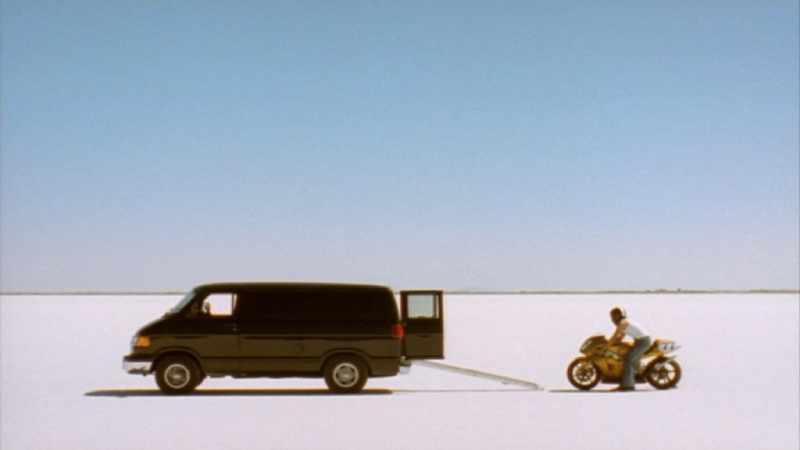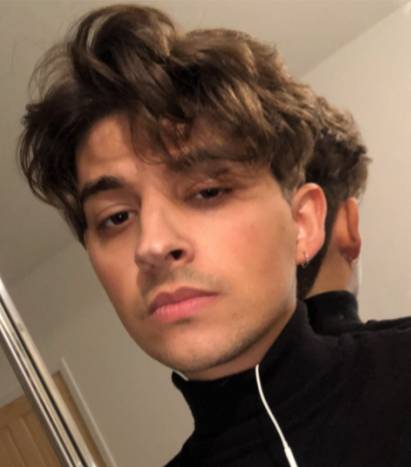




It’s almost certain two of the following responses will be heard when mentioning The Brown Bunny (2003) in conversation: “That one Ebert destroyed with a one-liner?”, or “Oh, that blow-job film?”. They’re dismissive statements, sure, but they’ve only heightened director Vincent Gallo’s film to underground cult statu
Leading up to the Cannes event, Gallo was already established as a cult actor to watch – with notable roles in films such as Arizona Dream (Emir Kusturica 1993), Trouble Every Day (Clare Denis, 2001), and a bit-part in Goodfellas (Martin Scorsese, 1990). But it was with his directional debut, Buffalo ’66 (1998) that he would receive his highest acclaim to date. Having written, composed, and acted in the leading role himself, the indie hit was an early showcase for Gallo’s auteur mastery. So given his rising profile, critics were eager for his next film – particularly those at Cannes.
Released back in 2003, The Brown Bunny premiered at the 56th Cannes Film Festival to a crippling audience reaction. Gallo had presented a minimalist road film centred around a lonely motorcycle racer, plagued by images of a lost love. With sparse dialogue, lengthy driving scenes, and a climax in the most literal sense – the film was a far cry from Buffalo ’66. So as expected, Brown Bunny was met with boos and utter dismissal.
It wasn’t until a public feud with critic Roger Ebert, who declared it “the worst film in the history of Cannes”, that the film’s notoriety gain traction. Harsh remarks were exchanged, with Gallo likening him to a “fat pig” and placing a hex on his colonoscopy – to which Ebert found “more entertaining than watching The Brown Bunny”. After the fallout, Gallo would describe the premiere as “the worst feeling I ever had in my life”. Gallo would go on to trim 25 minutes off the film’s runtime and release the edited cut we know today (the only version readily available), which Ebert later regarded as the film’s “salvation” and rewarded it a new thumbs-up rating.
.
Time to reconsider?
So, after all the fuss with Cannes, the ugliness of Gallo’s remarks, and the over-hype of an 16mm blowjob: Was there more to The Brown Bunny 20 years later? Definitely. The film captures a deep sense of loneliness like any of Antonioni’s works. It revels in moments of solace you only experience on the road, with no destination in sight. That need to escape your mind from the past that still lingers on. But above all, it’s an honest glimpse into the human condition.
The film follows motorcycle biker Bud Clay’s (Vincent Gallo) cross-country odyssey into California. Drifting between highways and familiar neighbourhoods, he encounters three different women named after flowers: Violet, Lily, and Rose. Failing to connect with any of them, he yearns for a lover from the past called Daisy (Chloe Sevigny). After leaving a note outside their old home to meet in a L.A motel, Bud contends with a tragic truth. With Gallo again taking full control of his film, including a lead role, it was easy for critics to label him indulgent and sleazy for his portrayal of sex. But instead, Gallo appears bare through the role of Bud Clay, exposing the myths of male sexuality.
Looking into Bud’s encounters with these three women, his words are shrouded in pleas and whispers. When he meets the young gas station clerk ‘Violet’, he utters “please?” three times to shotgun with him, only to leave her behind without a word. Later, Bud spots and makes love to the older lady ‘Lily’ (Cheryl Tiegs) at a park bench. This time It’s simply “You okay?” after an embrace that ends with him staring off from her glare. Fans of Buffalo ’66 may spot the body language overlap in Billy and Bud sheltering from women, with the bathtub scene mirroring Bud sitting shy on the motel bed.
Brown Bunny’s primary theme, however, remains loneliness. Every conversation Bud has leads him to know less about himself than before. All the deviations on his journey, leads him straight back at the wheel. After his first encounter, Bud visits Daisy’s parents to ask what became of her brown bunny. They fail to recognise him or a connection to their daughter, despite living next door. The brown bunny acts as closure to Bud’s searching, as moments later, he visits a pet store to ask of their life expectancy – six years, tops. He continues driving. There’s a particular kind of isolation in Brown Bunny that’s caught nowhere else. It’s the silent radio in Bud’s van. The sound weaving out on the racetrack. That dead-air in the parent’s responses.
Another reason the film was berated was its visual language. Gallo experiments with the road film model and makes it literal. Filmed in 16mm, we’re fastened in for the time it takes Bud’s van to roam past houses, or his motorbike to complete 4 laps of a circuit in the film’s opening (an unbroken 2-minute shot). Splattered bugs on a windshield puts us in a trance, while Bud is left with either his silence or a sombre folk tune (Beautiful by Gordan Lightfoot, or Milk and Honey by Jackson C. Frank).
With all the momentum on observation, Gallo unknowingly captures echoes of slowcCinema in his work, from the loose narrative to the lite-long takes put upon the viewer. The film’s key instance of this also happens to be its best scene. Bud speeds off onto the Booneville Speedway with his gold motorbike, until he becomes a distant blimp on the salty earth. It’ the film’s clearest metaphor on loneliness, lasting almost 2 minutes – the Cannes cut reportedly double in length, showing the bike returning. From the clear 70’s influence of its imagery, Brown Bunny starts to feel like its own genre of ‘Ambient-Americana’, a modern Two-Lane Backdrop (Monte Hellman, 1971), shot by way of James Benning, minus the James Taylor.

.
The end of it all?
But it remains the film’s final moments that have been the cause for all its derision 20 years later (featured on many a ‘controversial films’ list). Without spoiling: Bud receives a very real blowjob from Daisy, with no cut-away or censoring. Few are willing to defend the scene’s purpose, but the context is often far removed. At this point, Bud is caught at a point of tragic vulnerability. His reality has become a revelation to the audience, that he is alone with his own quiet intimacy. The sex depicted speaks guilt and confusion, rather than rapture or fantasy. With such a stirring image to confront the audience, it is no wonder many were quick to denounce the film outright.
Long after Brown Bunny, Gallo was yet to direct another film for the public eye. With his one other release being Promises Written in Water (2010), starring the late Sage Stallone. Having only been screened at the Venice and Toronto film festival of that year, any extra details or footage have proven scarce. Critics at the screenings have noted it as another experimental outing by Gallo, with one dance scene featuring the use of ‘Polygon Window’s “Quoth”. But given the indefinite hiatus, it’s likely the film will remain forever lost.
Audiences and filmmakers today have since re-evaluated Brown Bunny for the daring statements it provides. Acclaimed art-house directors such as Godard, Waters and Herzog have sung praise when no other critic would, with Josh Safdie placing it among his Sight & Sound top 10. But it’s also the dedicated circles on film sites like Letterboxd, who have scoured the internet for early drafts, Cannes cuts, and passed around a rare commentary that reveals much more than we knew.
For now, Brown Bunny remains Vincent Gallo’s swan song as a director. The work of a detested maestro, torn-out from the industry, swallowed by the Daily Wire, leaving only his million-dollar sperm for sale.











